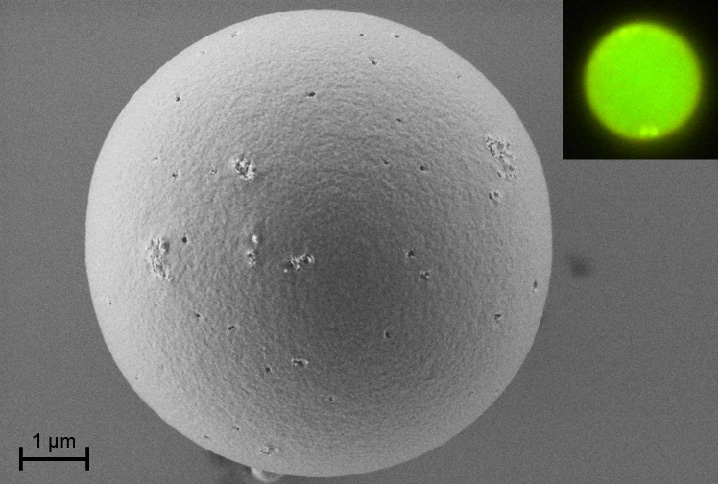Ultra-low threshold lasing in organic polymer blend microspheres with the highest Q factor
22.07.2024
 |
|
Microsphere of high quality factor made of a polymer blend, emitting fluorescence (upper right). Credit: Jorge González-Sierra. |
- Researchers at IMDEA Nanociencia fabricate high quality microspheres from conjugated organic polymer blends with excellent lasing properties.
- The laser emission of the microspheres has the highest quality factor reported to date, Q>18,000.
- The ultra-low lasing threshold and the very narrow lasing linewidths render the microspheres ideal for ultrasensitive sensing.
| Tweet |
Madrid, 22nd July, 2024. Dielectric optical microresonators confine and concentrate light in a tiny circular path due to multiple near total internal reflections at the curved dielectric-air interface, where light interferes constructively for certain wavelengths. These microresonators offer the possibility to achieve control of light confinement and propagation through precise adjustment of their shape, size and refractive index. Among them, spherical resonators are particularly interesting due to their high Q factors (ratio of the resonance frequency over its bandwidth) of the corresponding Mie resonances, or “whispering gallery modes”. The Q factor is in essence a measure of how well light can be trapped in the microsphere over time and high Q factors correspond to narrow lasing linewidths, a desired feature when designing laser applications.
The narrow resonances enable applications in the optical sensing field, including devices with high sensitivity to small physical or chemical variations in the optical near field of the resonators. Also, high Q factors pave the way for applications in the field of amplified spontaneous emission and lasing of microspheres made with luminescent materials.
So far, microlasers based on conjugated polymers have been reported with typical Q factors around 1.000. Conjugated polymers have emerged as excellent organic laser materials for their outstanding optoelectrical properties and facile processability. Among all resonator geometries, microspheres made of conjugated polymers combine large optical absorption with high photoluminescence quantum yield, affording an increase of brightness with respect to commercial dye-doped microspheres under the same photoexcitation conditions.
The microspheres fabricated at IMDEA Nanociencia exhibit laser emission with the highest quality factor reported to date, Q> 18,000 and ultra-low emission thresholds.
Researchers at IMDEA Nanociencia, led by Dr. Reinhold Wannemacher and Dr. Juan Cabanillas, have now reported microspheres based on conjugated polymer blends exhibiting lasing with the highest quality factor reported to date, Q> 18.000 and ultralow lasing thresholds. The reported low lasing thresholds are based on the energy transfer (Förster Resonant Energy Transfer, FRET) between the polymer constituents of the blends, a mechanism which reduces residual absorption at the lasing wavelength. Such low thresholds are promising for the development of microlasers which can be pumped by low-cost laser diodes.
Together, low thresholds and narrow lasing linewidths enable ultrasensitive detection of variations of physical parameters (pH, temperature) as well as chemical composition of the environment of the microspheres and, in the case of microspheres with surfaces functionalized by specific organic groups, ultra-sensitive and highly specific detection of biomolecules. The latter is highly relevant for the development of portable and low cost biodetectors which would enable rapid diagnosis of diseases at points of care.
This work has been carried on at IMDEA Nanociencia and is partially funded by the Excellence Severo Ochoa Grant awarded to IMDEA Nanociencia by the Spanish Ministry of Science and Innovation.
Reference:
J. González Sierra, A. Martin-Merinero, J. Álvarez-Conde, S. Iglesias Vázquez, J. Cabanillas-González, R. Wannemacher, High Q Ultra-Low Threshold Lasing in Conjugated Polymer Blend Microspheres Promoted by FRET. Adv. Optical Mater. 2400161 (2024). DOI: 10.1002/adom.202400161
![]() https://repositorio.imdeananociencia.org/handle/20.500.12614/3642
https://repositorio.imdeananociencia.org/handle/20.500.12614/3642
Contact:
Reinhold Wannemacher
This email address is being protected from spambots. You need JavaScript enabled to view it.
Nanooptics and Nanoacoustics Group
Juan Cabanillas
This email address is being protected from spambots. You need JavaScript enabled to view it.
Pump-probe Photoinduced Absorption Spectroscopies Group
https://nanociencia.imdea.org/pump-probe-and-photoinduced-absorption-spectroscopies/home
Oficina de Divulgación y Comunicación en IMDEA Nanociencia
divulgacion.nanociencia [at]imdea.org
Twitter: @imdea_nano
Facebook: @imdeananociencia
Instagram: @imdeananociencia
Source: IMDEA Nanociencia.




